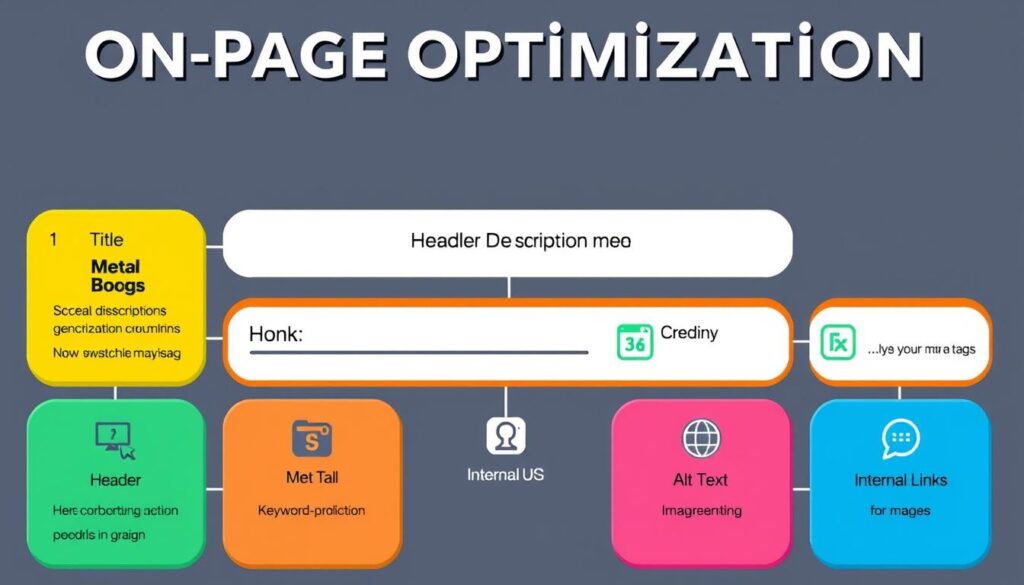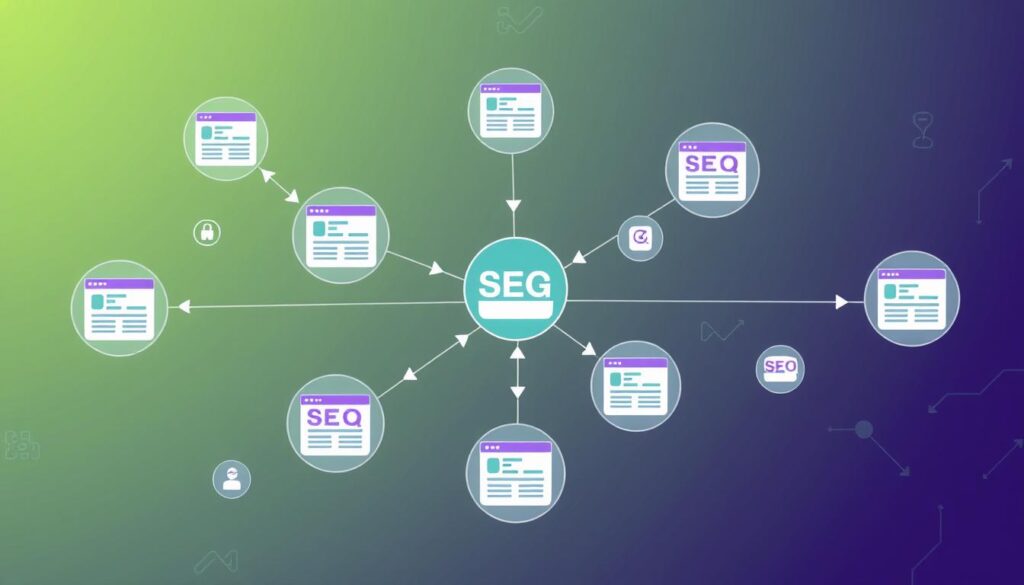Did you know that more than 61% of title tags displayed in Google search results are rewritten? This startling statistic underscores the importance of mastering on-page optimization to ensure your website ranks high on search engine results pages (SERPs). In the digital landscape, effectively implementing SEO strategies is more crucial than ever. By focusing on on-page optimization, you can elevate your website optimization efforts and enhance your visibility online.
On-page SEO encompasses diverse areas such as content quality, keyword integration, and the use of meta tags, all of which contribute to a seamless user experience. When you adopt proven SEO best practices, you’ll not only attract more organic traffic but also improve your site’s credibility. By controlling what your site communicates to search engines, you hold the key to driving significant traffic and achieving your marketing goals.
So let’s dive into the finer points of on-page optimization and discover how you can maximize your website’s performance through effective techniques and strategies. This involves fine-tuning elements like meta tags, headers, and content to ensure they align with targeted keywords and provide value to users. Additionally, one crucial aspect of on-page optimization is ensuring that your website is mobile-friendly. Implementing key mobile optimization tips for websites, such as using responsive design, optimizing page load speed, and simplifying navigation, can greatly enhance user experience and boost search engine rankings.
Key Takeaways
- Understanding the importance of title tags and meta descriptions for effective search visibility.
- Recognizing the impact of page load speed on user experience and SEO rankings.
- Utilizing internal links to boost page authority and navigation ease.
- Employing keywords in a strategic manner, focusing on long-tail keywords for better targeting.
- Enhancing the credibility of your content through relevant external links.
- Optimizing images to improve site speed and accessibility, using alt text effectively.
- Leverage comprehensive tools like Google Keyword Planner for insightful keyword research.
Understanding On-Page Optimization
On-page optimization refers to the methods used to enhance individual web pages to improve their search engine rankings. This includes a variety of techniques aimed at both search engines and user experience. With the right on-page SEO strategies, you can directly influence your website traffic and improve your Google rankings.
What is On-Page Optimization?
On-page optimization involves refining various elements on your website to ensure they align with search engine algorithms and user search intent. These elements include content, title tags, meta descriptions, header tags, and URL structures. Each of these factors plays a critical role in signaling to search engines what your page is about, which guides their decision on how to rank it. By focusing on these controllable aspects, you have the potential to achieve significant improvements in visibility.
Importance of On-Page SEO for Your Website
The SEO importance of on-page optimization cannot be overstated. Well-optimized pages lead to higher Google rankings, which results in increased organic traffic. This process enables you to directly communicate the value and purpose of your site, making it easier for users and search engines to understand your content. Elements such as structured headings, relevant keywords, and effective internal linking are essential in ensuring that your pages can be easily indexed and ranked appropriately.

Furthermore, optimizing for user experience is equally vital, as it fosters engagement and reduces bounce rates. When you create content that resonates with the audience’s needs and expectations, you enhance both user satisfaction and search engine performance. By mastering on-page optimization techniques, you can positively impact your overall digital strategy and maximize your online presence.
Key Elements of On-Page Optimization
Effective on-page optimization relies on several crucial elements, each playing a significant role in enhancing your site’s visibility and user engagement. Understanding how to leverage these elements can lead to improved SEO performance.
Title Tags
Title tags serve as the first impression users receive in search engine results pages (SERPs). These HTML elements should be unique and engaging, incorporating relevant keywords that clearly reflect the content on your page. A well-crafted title can greatly influence click-through rates, driving traffic to your website.
Meta Descriptions
While meta descriptions do not directly affect rankings, they are essential for encouraging user clicks. These brief summaries help users understand what to expect from your page. Including targeted keywords in your meta descriptions can improve engagement and, over time, contribute positively to your site’s SEO performance.
Header Tags
Header tags (H1, H2, H3) help organize content effectively. Utilizing these HTML elements allows for better readability and a clearer content hierarchy, both for users and search engines. Properly structured header tags not only improve user experience but also support search engines in understanding the context and importance of your content.

Crafting Quality Content for SEO
Creating quality content forms the backbone of effective SEO strategies. You need to ensure that your content not only resonates with your audience but also aligns with the intricacies of search engine algorithms. Relevance and keyword integration play a critical role in this process, ultimately guiding users to your website while enhancing your visibility online.
Relevance and Keyword Integration
A deep understanding of your target audience starts with thorough market research and competitor analysis. This knowledge allows you to create profile personas that represent your audience’s demographics, goals, and challenges. Tools like Google Keyword Planner aid in identifying long-tail keywords that reflect their search intent. Incorporate these keywords seamlessly throughout your content for maximum effectiveness. Aim for a balance between keyword integration and delivering high-quality content, fostering user engagement.
Enhancing Readability and Engagement
To optimize user engagement, your content should be easy to navigate and visually appealing. Use a clear hierarchy of headings, including H1, H2, and H3 tags, to improve readability and search engine optimization. Structuring your content effectively helps readers digest information better. Additionally, engaging headlines significantly boost click-through rates, drawing users in and driving organic traffic. Your content must offer value, aiming to solve problems while being presented in varied formats like text, video, and infographics to keep readers interested.

| Element | Importance |
|---|---|
| Market Research | Understanding audience needs and preferences |
| Keyword Integration | Aligning with search intent for better visibility |
| Readability | Enhancing user experience and engagement |
| Engaging Headlines | Increasing click-through rates |
| Content Formats | Diversifying presentation to maintain interest |
Image Optimization for Better Rankings
Image optimization plays a crucial role in enhancing your website’s overall performance and ranking. It focuses on improving the quality of images while ensuring faster loading times, which leads to a better user experience. By following best practices and employing effective strategies, you can fully leverage image SEO benefits.
Alt Text Best Practices
Utilizing alt text is essential for describing images to search engines and improving accessibility for users. This text informs visitors using screen readers about the content of the images. Here are some best practices to follow:
- Be descriptive: Provide clear, relevant descriptions of your images to enhance understanding.
- Avoid keyword stuffing: Keep your alt text natural and refrain from overloading it with keywords.
- Use unique alt text: Each image should have its own distinct alt text to avoid confusion.
As Google uses alt text, along with computer vision, to assess the subject matter of images, maintaining concise yet informative alt attributes contributes significantly to your image SEO efforts.
File Naming Strategies
Effective file naming is another critical aspect of image optimization. Adopting clear and descriptive file names aids search engines in understanding the content of the images. Consider these tips:
- Use relevant keywords: Incorporate related keywords into your file names that reflect the image content.
- Keep it concise: Ensure file names are straightforward and easy to read.
- Separate words with hyphens: Use hyphens instead of underscores to separate words in the file name for clarity.
Optimal file naming not only helps with image SEO but also enhances the overall usability of your website, as search engines index your content more effectively. Remember to take advantage of image formats supported by Google, such as JPEG, PNG, WebP, BMP, GIF, and AVIF, to further improve your images’ loading speeds and quality.

Internal Linking: Boost Your SEO
Internal linking serves as a foundational strategy to enhance your website’s navigation and SEO benefits. By connecting various pages on your site, you guide both users and search engines through your content. This approach aids in establishing clear relationships between your posts and pages, facilitating better understanding of your site’s structure.
Benefits of Internal Linking
Utilizing internal linking effectively can lead to several advantages:
- Improved user experience: Internal links help visitors navigate your website more intuitively, making it easier for them to find relevant content.
- Better SEO rankings: Search engines, like Google, follow these links to discover and rank your content, meaning well-placed internal links can enhance visibility.
- Distribution of link equity: Internal links spread the authority and value of your pages, ensuring important content receives the attention it deserves.
- Reduced bounce rates: By encouraging visitors to explore more pages, internal linking can increase dwell time, a factor that search engines take into account for rankings.

How to Create Effective Internal Links
Creating effective internal links involves several strategic considerations:
- Use descriptive anchor text: Vary your anchor text to indicate the content you are linking to, helping both users and search engines understand relationships.
- Link relevant pages: Ensure that your links are contextually relevant, connecting related content to build a stronger internal framework.
- Prioritize important pages: Internal links from your homepage or key navigational spots can significantly enhance the authority of essential posts.
- Regular audits: Conduct routine checks on your internal linking strategy to ensure effective distribution and to address orphaned content.
- Limit excessive links: Avoid cluttering a page with too many internal links, as this can dilute the value passed to individual pages.
Measuring On-Page Optimization Success
Understanding how to measure the success of your on-page optimization is crucial for effective digital marketing. By focusing on essential SEO metrics, you can evaluate the performance analysis of your strategies. Key indicators such as organic traffic, bounce rates, and conversion rates contribute significantly to assessing how well your content aligns with user intent. By tracking success in these areas, you gain insight into your website’s effectiveness and audience reach.
Essential SEO Metrics to Track
To gauge the impact of your on-page optimization, monitor metrics like keyword rankings, website authority, and click-through rates (CTR). These metrics not only reveal your site’s position in search results but also help you understand user engagement and experience. Conversions are vital proof that your content resonates with visitors. As you analyze these indicators, it’s essential to also note time spent on pages and bounce rates; they provide valuable information about user interaction and satisfaction levels.
Tools for Analyzing On-Page Performance
Utilizing trusted on-page optimization tools, such as Google Analytics, SEMrush, and Ahrefs, can enhance your performance analysis capabilities. These platforms allow you to track vital metrics, including organic traffic and backlink quality, to refine your strategies effectively. Remember, the insights gained from these tools are crucial in establishing a data-driven approach to your SEO efforts, helping you adapt and optimize for better visibility and engagement over time.
FAQ
What is on-page optimization?
Why is on-page SEO important for my website?
How can title tags impact my SEO efforts?
What role do meta descriptions play in SEO?
How can I optimize my content for better SEO?
What are the best practices for image SEO?
How does internal linking benefit my site’s SEO?
What metrics should I track to measure on-page optimization success?
Which tools can I use to analyze my on-page performance?
Erik – Email, SEO, AI Expert Writer Erik is the strategist, the thinker, and the visionary. His role at LeftBrainMarketing is pivotal in integrating SEO with AI-driven content strategies. With an extensive background in email marketing and a profound understanding of search engine algorithms, Erik develops innovative strategies that elevate our client’s online presence. His work ensures that our content is seen, felt, and remembered.










